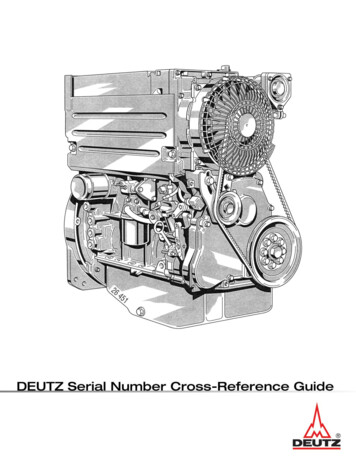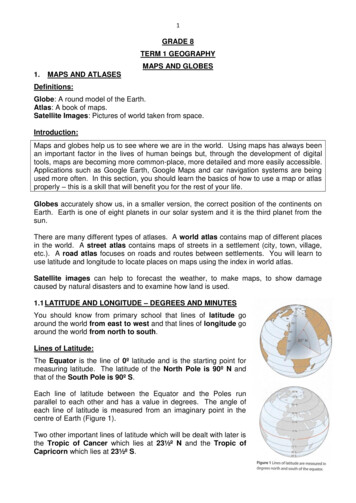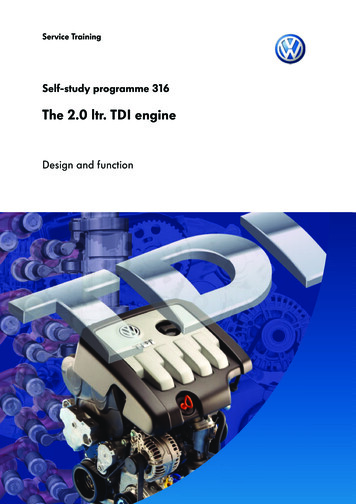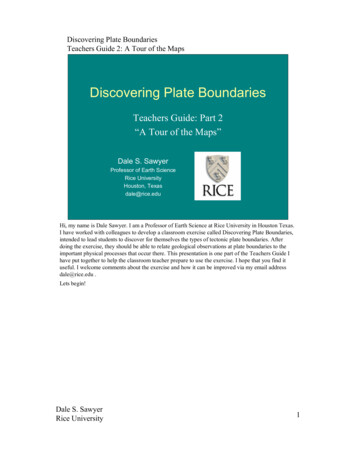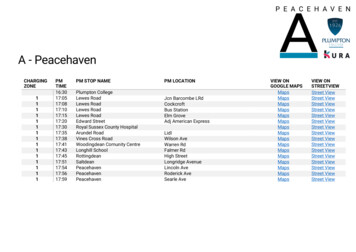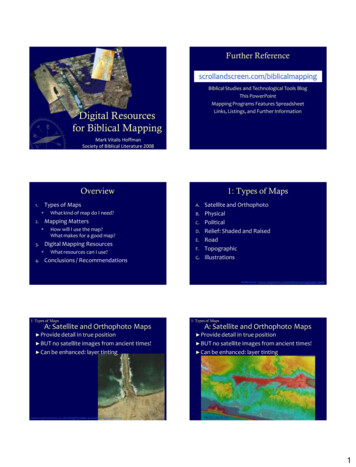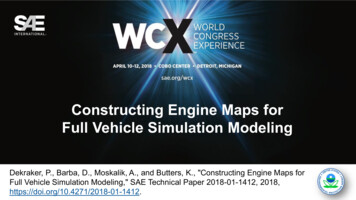
Transcription
Constructing Engine Maps forFull Vehicle Simulation ModelingDekraker, P., Barba, D., Moskalik, A., and Butters, K., "Constructing Engine Maps forFull Vehicle Simulation Modeling," SAE Technical Paper 2018-01-1412, 2018,https://doi.org/10.4271/2018-01-1412.
BackgroundEPA is tasked with assessing the effectiveness of new automotivetechnologies in meeting current and future GHG standardsWell Documented Engine and Vehicle Data are Necessary to: Assess the effectiveness of new automotive technologies Accelerate development and refinement of new technologies Examine behavior in real world operationVehicle BenchmarkingValidation ModelingEngine BenchmarkingFleet Level ModelingLiterature ReviewDemonstration ProjectsSAE INTERNATIONAL2018-01-14122
Validation vs Fleet Level ModelingValidation ModelCOMPONENTTEST DATASURROGATEDATAFleet ModelingMODELINPUTSSINGLEVEHICLEMODELExamine Phase & Time Series DataEnsure Losses are CharacterizedThousands of Vehicle ModelsMODEL INPUTSRESPONSESURFACESSAE INTERNATIONAL2018-01-1412Examine / PredictEffectiveness ofNew Technologies3
Constructing Engine MapsThis Paper & Presentation Describe the Important Factors & Approach forConstructing Engine Maps Which: Translate component data consistently into model inputs Produce an accurate characterization of the fleet Characterize the effectiveness of technology improvements across the fleet Ensure technologies are evaluated equitablySAE INTERNATIONAL2018-01-14124
What is ALPHAEPA’s Advanced Light-Duty Powertrain & Hybrid Analysis (ALPHA) ToolPhysics Based Full Vehicle Simulation Constructed in Simulink Engine Transmission(AT/CVT/AMT/DCT) Wheels & Axles Chassis & Roadload EV & Hybrid Powertrains(not released publically yet)SAE INTERNATIONAL2018-01-14125
ALPHA Engine Model 0-D Based around fuel mapversus torque and speed Time constants providetorque response Dynamic lookup tables Allows inclusion of anymodel variablesSAE INTERNATIONAL2018-01-14126
Engine Fuel Map AdjustmentsBase fuel map accounts for 95 % of fuel consumptionOther adjustments for transient operation applied beyond base fuel map: Deceleration fuel cutoff Cylinder deactivation transitions Transient fueling Enrichment Inertia compensation during transmission shiftingSAE INTERNATIONAL2018-01-14127
Engine Dynamometer Test DataThree Areas with Different Test Methods Low / Mid-Load – Core MapLong Steady State ModesStable Speed, Torque & FuelStoichiometric - Limit λ 1Sample Test Points for2016 Honda 1.5L Turbocharged I4High Load Low Speed / Near IdleCore MapLow / Mid Load High Load – TransientIdle / LowSpeedTest data available SAE INTERNATIONAL2018-01-14128
Low Speed / Near Idle Test DataChallenges Testing as Low Speed Large dynamometer inertia and hightorsional stiffness make low speedoperation difficult Engine operation can interact withengine control logic leading toinstabilityExample Setup with CVTDynoAuxiliarytransmissionHBMtorquesensorCVT ywheelOptions: Incorporate a transmission Into the test setup Perform in-vehicle fuel consumption measurementsSAE INTERNATIONAL9
High Load Test DataDefines Two Time Windows Initial – After engine achieves desiredoperation point (often stoichiometric) Final – Similar to steady state, may belimited by time or temperature criteria– Data may not be stableNeed Reliable Fuel Flow Measurementover Short Duration Estimate fuel flow via injectorduration and fuel pressureSAE INTERNATIONAL2018-01-141210
Capturing Data from Published ImagesValuable Source of Relevant Data Timely Low EffortImportant Considerations: Often Partial Maps Unknown Test Procedures Development Status Fuel PropertiesSAE INTERNATIONAL2018-01-141211
ALPHA Engine Map Generation Overview1.2.3.4.5.Define operating envelope to be covered by the mapDefine speed and load grid for fuel map constructionGenerate fuel map from input dataExamine resulting fuel map and revise data if necessaryApply adjustments for transient operationSAE INTERNATIONAL2018-01-141212
Defining Operating Range – Maximum TorqueProvides a Bound toConstruct Fuel Map GridImportant for DeterminingEngine Displacement inFleet Level Modeling Future technologypackages must maintainperformance Higher power createsmore opportunity todownsizeSAE INTERNATIONAL2018-01-141213
Defining Operating Range – Maximum TorqueMaximum Torque – Sweep vs Stab TestSweep Speed at Maximum Torque Fast, easy test to execute Can show features that otherwise may be overlooked Slow transient can cause thermal protection to limit torque at high speed Fast transient increases error in torque measurement due to inertiaTorque Stab at Fixed Speed - Preferred More tedious, especially for a fine grid Provides greatest torque measurement accuracy Provides additional information about fueling during transient operationSAE INTERNATIONAL2018-01-141214
Defining Operating Range – Minimum TorqueMinimum Torque Curve Impacts: Available energy for mild hybrids Advanced alternator strategiesDefault Minimum Torque CurveCan be Constructed Using: Steady state dynamometer test data Need a default curve for maps built frompublished images Biased toward higher friction May be revised using the fuel mapSAE INTERNATIONAL2018-01-141215
Defining the Fuel Map GridGridded Fuel Map Desirable to Simplify Interpolation and Speed Simulation Build grid to match input data Look for clusters in speed & torque data Minimum spacing between clusters Minimum number of points per cluster Add intermediate grids for sufficientcoverage Linear interpolation of a non-linear surface Image based maps use a default gridSAE INTERNATIONAL2018-01-141216
Surface Fitting - NormalizationNon-Normalized Voronoi Distance determines weighting forsurface fitting Scattered data necessitates speed &torque data points be of similar scaleto generate satisfactory results Regions surrounding each input datapoint influence the resulting fuel map Appropriately balanced weighting ofneighboring pointsSAE INTERNATIONAL2018-01-141217
Surface Fitting - NormalizationNormalized Voronoi Distance determines weighting forsurface fitting Scattered data necessitates speed &torque data points be of similar scaleto generate satisfactory results Regions surrounding each input datapoint influence the resulting fuel map Appropriately balanced weighting ofneighboring pointsSAE INTERNATIONAL2018-01-141218
Surface Fitting - NormalizationSAE INTERNATIONAL2018-01-141219
Interpolation vs Surface FittingBehavior of Matlab’s Scattered-Interpolant Class – Triangulation of DataEach grid point is determined by plane of three surrounding input pointsLarge Void ImpactsExpected Overall TrendMissing Peak IslandSAE INTERNATIONAL2018-01-141220
Surface Fitting with GRIDFIT*GRIDFIT is a not an interpolantGenerates system of equations and seeks to minimize: Error between data and surface 2nd derivative of the resulting surface Smoothness is the relative weightingA Smooth Fuel Map: Ensures more consistent gearselection behavior Assists in generating a moreregular knock sensitivity adjustmentwhen scaling engine mapsSAE INTERNATIONAL* GRIDFIT developed by John D’Errico2018-01-141221
Interpolation vs Surface FittingSurface fitting takes the trends of the entire data set to fill void or extrapolationCan remove some noise in the test dataSAE INTERNATIONAL22
QC Tools & Engineering JudgmentQuality Checks Confirm the Accuracy of the Resulting Fuel MapIterative Process to Ensure the Final Map Represents Appropriate TrendsConducted by: Comparing input data with the resulting BSFC or BTE contour plots Verifying the trends within any areas of the map which are extrapolated fromtest data sets match expectations Applying reasonable judgment and adding a collection of estimated data pointsas needed or further examination of source data Comparing fuel flow to chassis test measurements & similar engines or vehicles– can be difficult to obtain in-vehicle torque measurementsSAE INTERNATIONAL2018-01-141223
QC - Handling Limited Data Sets Published images often provide partial mapsNeed to correct poor extrapolationEnsure appropriate controls behavior in simulationSAE INTERNATIONAL2018-01-141224
QC – Adding Data PointsAdding estimated data points creates a more appropriate fuel mapSAE INTERNATIONAL2018-01-141225
QC – Fuel Linearity PlotsFuel per Stroke Contour PlotRoughly Parallel toMinimum TorqueReduced Efficiencyat IdleSAE INTERNATIONAL2018-01-141226
QC – Fuel Linearity PlotsPower EnrichmentFuel per Stroke vs TorqueKnock ControlRoughly ParallelIncreasing consumption with speedSAE INTERNATIONAL2018-01-141227
Transient Adjustments Deceleration Fuel Cutoff * Cylinder Deactivation Transitions * Transient Fueling * Enrichment Inertia Compensation During Transmission Shifting ** More detailed discussion of how these factors are implemented in ALPHA isdescribed in SAE Technical Paper 2017-01-0533SAE INTERNATIONAL2018-01-141228
Default adjustment factor 1.3x multiplier Ramped out over 1.1 seconds Only activates after 2 secondsSAE INTERNATIONAL22242628302426283024262830Eng Trq 2327654332Gear NumberEasy to capture on enginedynamometer or via chassistesting2000RatioAdditional fueling followingfuel cut-off eventFueling Rate Eng Spd (RPM)(g/s)Post DFCO Additional Fueling29
Additional fueling beyond non-CDA levelDefault adjustment 1.3x multiplierramped down over 2 secondsFuelingrate 0440154656030442Time (sec)SAE INTERNATIONAL44435130044060CDA Disengagement 0.7444455460Eng Trq (Nm)TPS (%)Reduction in fueling not instantaneousDefault transition blending: 1 second0.504401500Sprk Avd(CAD) 0.9Cam Pst(CAD)CDA Engagement1Eng Spd(RPM)Developed Based on Observations of2014 Chevrolet SilveradoCyl DeacCylinder Deactivation Adjustment0465Time (sec)30
Transient Operation Adjustment0.35Engine Torque0.20.15Pedal (x50)0.1Adjustment Factor0.25Fueling rate (g/s)Engine Torque (Nm)0.30.050Time (sec)Normalized Power RateTransient operation is observed to be less efficient than steady stateDefault adjustment multiplier is 1.4 scaled by engine power rateRarely observe normalized power rate above 0.3(b)SAE INTERNATIONAL2018-01-141231
EnrichmentSimulating Enrichment Depends on: Amount of additional fuel to add How / when to transition fromstoichiometric operation toenriched operationHigh load test method provides agood method to determine bothOff-cycle PhenomenaPoint of Reference for Engine ScalingSAE INTERNATIONAL2018-01-141232
Summary – All Areas of OperationMaps Covering All Areas ofEngine OperationHigh Load Low / Mid-Load Low Speed / Near Idle High Load – TransientCore MapLow / Mid LoadCore MapLow / Mid LoadIdle / LowSpeedTest Data & Input Files Available ologySAE INTERNATIONAL2018-01-141233
Summary – Consistent Engine Map Process1. Define operating envelope2. Define speed & load grid3. Generate fuel map4. Examine resulting map5. Apply transient adjustmentsSAE INTERNATIONAL2018-01-141234
Summary – Available ExamplesALPHA & Input Files Available brid-analysis-alphaIncludes: Generation process document Resulting ALPHA input m-file Fuel map images and dataSAE INTERNATIONAL2018-01-141235
CDA Engagement Reduction in fueling not instantaneous Default transition blending: 1 second CDA Disengagement Additional fueling beyond non-CDA level Default adjustment 1.3x multiplier ramped down over 2 seconds 30 Cylinder Deactivation Adjustment 2018-01-1412 440 442 444 0 0.
